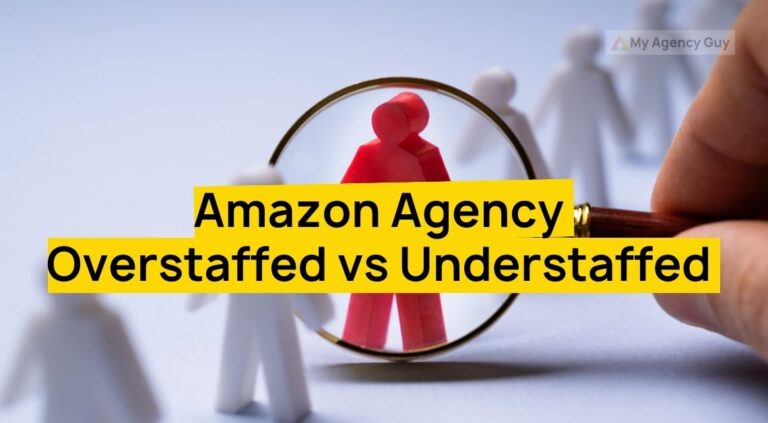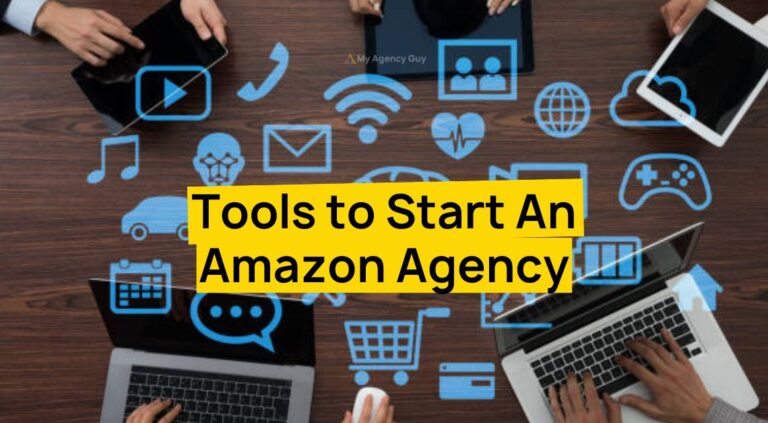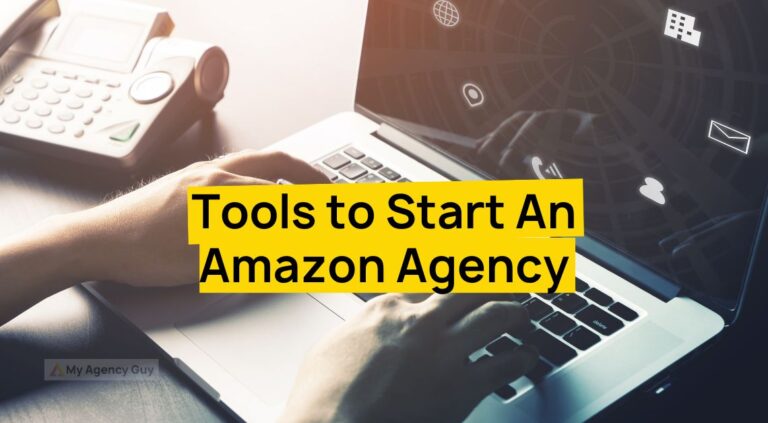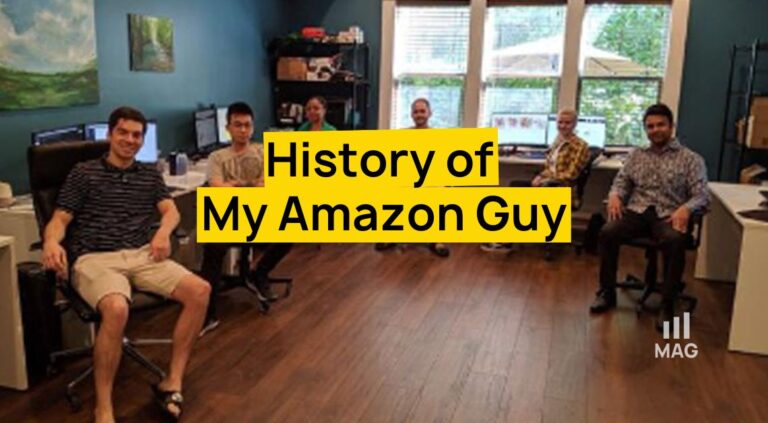16 Steps To Optimize An Amazon Agency Sales Process
The significance of the Amazon Agency Sales Process cannot be overstated, as it serves as the foundation of the agency’s operations, contributing significantly to its ongoing success.
In this recent article, we’ll thoroughly explore the various steps within the sales process, providing valuable insights to assist you in crafting a path to profitability for your agency.
Continue reading to gain a comprehensive understanding of the whats, whens, wheres, hows, and whys of the sales process.
1. Amazon Agency Sales Process: Prospecting
What: Prospecting is the process of identifying potential clients who could benefit from your Amazon agency’s services.
When: Prospecting is an ongoing process, but it is especially important when you are first starting your agency or when you are expanding your services.
Where: Prospecting can be done online or offline. Online prospecting can involve researching Amazon sellers on Amazon.com, using lead-generation tools, or attending industry events. Offline prospecting can involve networking with other Amazon sellers, attending trade shows, or cold calling.
Check out this image below featuring the four cores of our lead generation here at My Amazon Guy.

How: There are many different ways to prospect for Amazon agency clients.
Some common methods include:
- Researching Amazon sellers: You can use Amazon’s search function or third-party tools to find Amazon sellers who meet your criteria. For example, you might target sellers with high sales volume, good customer reviews, or products that are similar to those of your existing clients.
- Using lead-generation tools: There are several lead-generation tools available that can help you find Amazon sellers who are interested in agency services. These tools typically work by scraping Amazon seller data or by tracking Amazon sellers’ social media activity.
- Attending industry events: Industry events are a great place to meet potential clients and learn about their needs. Some popular Amazon industry events include Seller Central Live, Amazon Accelerate, and the Private Label Summit.
- Networking with other Amazon sellers: Networking with other Amazon sellers is a great way to learn about the industry and to find potential clients. You can network with other sellers online through forums and social media groups, or offline by attending industry events or joining local Amazon seller groups.
- Cold calling: Cold calling can be a time-consuming process, but it can also be very effective. When cold calling potential clients, be sure to introduce yourself and your agency clearly and concisely, and explain how your services can help the client achieve their goals.
Why: Prospecting is important because it is the first step in the sales process.
By identifying and qualifying potential clients, you can increase your chances of closing new deals and growing your Amazon agency business.
Here is an example of how to prospect for Amazon agency clients:
- Use a lead-generation tool to find Amazon sellers who meet your criteria.
- Filter the results to find sellers who are interested in agency services.
- Reach out to the sellers via email or phone and introduce yourself and your agency.
- Schedule a call to learn more about the seller’s business and needs.
- Qualify the seller to determine if they are a good fit for your agency.
- If the seller is a good fit, create a proposal and present it to them.
- Negotiate the terms of the contract and close the deal.
2. Amazon Agency Sales Process: Cold Calling/Outreach
What
Cold calling/outreach is the process of initiating contact with potential clients via phone calls, emails, or LinkedIn messages.
When
Cold calling/outreach is typically done during the prospecting stage of the sales process. However, it can also be used to reach out to existing clients or to promote new services.
Where
Cold calling/outreach can be done from anywhere, but it is important to find a quiet place where you can focus on your conversation and avoid distractions.
How
There are a few different ways to cold call/outreach to potential clients. Some common methods include:
- Phone calls: Phone calls are the most direct way to reach out to potential clients. However, it is important to be prepared and to have a clear script in mind.
- Emails: Emails are a less direct way to reach out to potential clients, but they can be more effective if they are personalized and relevant.
- LinkedIn messages: LinkedIn messages are a great way to reach out to potential clients who are already familiar with your brand.
Why
Cold calling/outreach is important because it allows you to reach out to potential clients who you may not have been able to connect with otherwise. It is also a great way to build relationships and trust with potential clients.
Here are some tips for cold calling/outreach to potential clients:
- Do your research: Before you reach out to a potential client, be sure to research their business and needs. This will help you to tailor your pitch and make it more relevant.
- Be prepared: Have a clear script in mind for your phone calls and emails. This will help you to stay on track and to deliver your message effectively.
- Be personal: Personalize your outreach by mentioning the client’s business or by referencing something you have in common.
- Be brief: Get to the point quickly and explain how your agency can help the client achieve their goals.
- Be persistent: Don’t give up if you don’t get a response right away. Keep trying and eventually you will reach someone who is interested in your services.

By following these tips, you can develop a successful cold calling/outreach process that will help you acquire new clients and grow your Amazon agency business.
Here is an example of how to cold call a potential client:
- Introduce yourself and your agency.
- Explain how you found the client’s contact information.
- Briefly explain your agency’s services and how you can help the client achieve their goals.
- Ask the client if they are interested in learning more.
- If the client is interested, schedule a call to discuss their needs in more detail.
3. Amazon Agency Sales Process: Client’s Needs Assessment
What
A client needs assessment is a process of identifying and understanding the client’s needs and challenges. This is an important step in the sales process, as it allows you to tailor your services to the client’s specific needs and to demonstrate how your agency can help them achieve their goals.
When
A client needs assessment should be conducted during the early stages of the sales process, typically after you have qualified the lead and scheduled a call with the client.
Where
A client needs assessment can be conducted over the phone, in person, or via video call.
How
There are a few different ways to conduct a client needs assessment. One common method is to simply ask the client about their needs and challenges. You can also ask them about their goals, their budget, and their timeline.
Another method is to conduct a competitive analysis to identify the client’s strengths and weaknesses. You can also use data analytics to identify areas where the client can improve.
Once you have gathered this information, you can begin to determine how your agency’s services can address the client’s specific needs and challenges. Be sure to tailor your recommendations to the client’s business and goals.
Why
A client needs assessment is important because it allows you to:
- Understand the client’s needs and challenges
- Tailor your services to the client’s specific needs
- Demonstrate how your agency can help the client achieve their goals
- Build trust and rapport with the client
Here are some tips for conducting a client needs assessment:
- Be prepared: Have a list of questions prepared in advance. This will help you to stay on track and to gather the information you need.
- Be attentive: Listen carefully to the client’s responses and ask clarifying questions as needed.
- Be objective: Avoid making assumptions about the client’s needs or challenges. Instead, focus on understanding their unique situation.
- Be helpful: Provide the client with valuable insights and recommendations. This will help you to demonstrate your expertise and build trust.
By following these tips, you can conduct effective client needs assessments that will help you close more deals and grow your Amazon agency business.
Here is an example of how to conduct a client needs assessment:
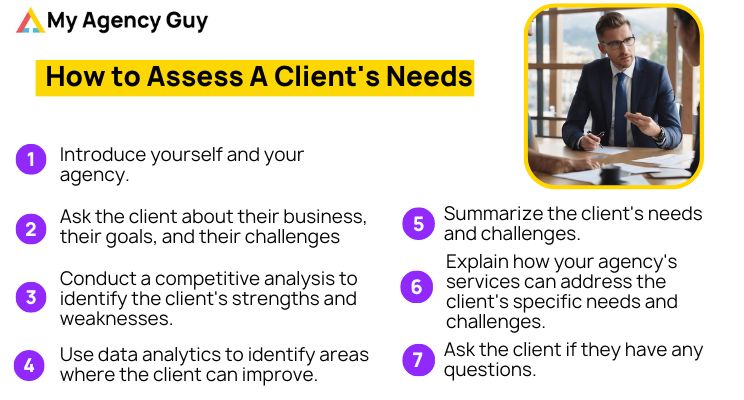
4. Amazon Agency Sales Process: Proposal and Presentation
What
A proposal is a document that outlines the services that your agency will provide to the client, as well as the timeline, budget, and expected results. The presentation is an opportunity to deliver the proposal to the client and to highlight the value that your agency can bring.
When
The proposal and presentation should be delivered to the client after you have conducted a client needs assessment and developed a customized plan to address the client’s specific needs and challenges.
Where
The presentation can be delivered in person, over the phone, or via video call.
How
The proposal should be clear, concise, and easy to understand. It should include the following information:
- An introduction to your agency and its services
- A summary of the client’s needs and challenges
- A detailed plan for how your agency will address the client’s needs and challenges
- A timeline and budget for the project
- Expected results
The presentation should be engaging and informative. It should highlight the key benefits of working with your agency and how your agency can help the client achieve their goals. You should also be prepared to answer any questions that the client may have.
Why
The proposal and presentation are important because they allow you to:
- Demonstrate your expertise and understanding of the client’s business
- Propose a customized plan to address the client’s specific needs and challenges
- Highlight the value that your agency can bring
- Build trust and rapport with the client
- Close the deal
Here are some tips for creating a winning proposal and presentation:
- Tailor the proposal to the client’s specific needs and challenges. Avoid using generic templates.
- Be clear and concise. Avoid using jargon or technical terms that the client may not understand.
- Highlight the benefits of working with your agency. Focus on how your agency can help the client achieve their goals.
- Be transparent about your pricing. Avoid hidden fees and surprises.
- Be prepared to answer questions. Anticipate the questions that the client may have and prepare answers in advance.
- Deliver a professional and engaging presentation. Use visuals and storytelling to make your presentation more engaging.
By following these tips, you can create a winning proposal and presentation that will help you close more deals and grow your Amazon agency business.
Here is an example of how to create a proposal and presentation:
- Conduct a client needs assessment to understand the client’s specific needs and challenges.
- Develop a customized plan to address the client’s needs and challenges.
- Write a proposal that outlines the services you will provide, the timeline, budget, and expected results.
- Schedule a presentation to deliver the proposal to the client.
- Deliver a professional and engaging presentation that highlights the benefits of working with your agency and how your agency can help the client achieve their goals.
- Be prepared to answer any questions that the client may have.
- Follow up with the client to answer any additional questions and to close the deal.
5. Amazon Agency Sales Process: Negotiation and Agreement
What
Negotiation and agreement is the process of discussing and agreeing on the terms of the contract between the Amazon agency and the client. This includes discussing the scope of work, pricing, and any specific requirements.
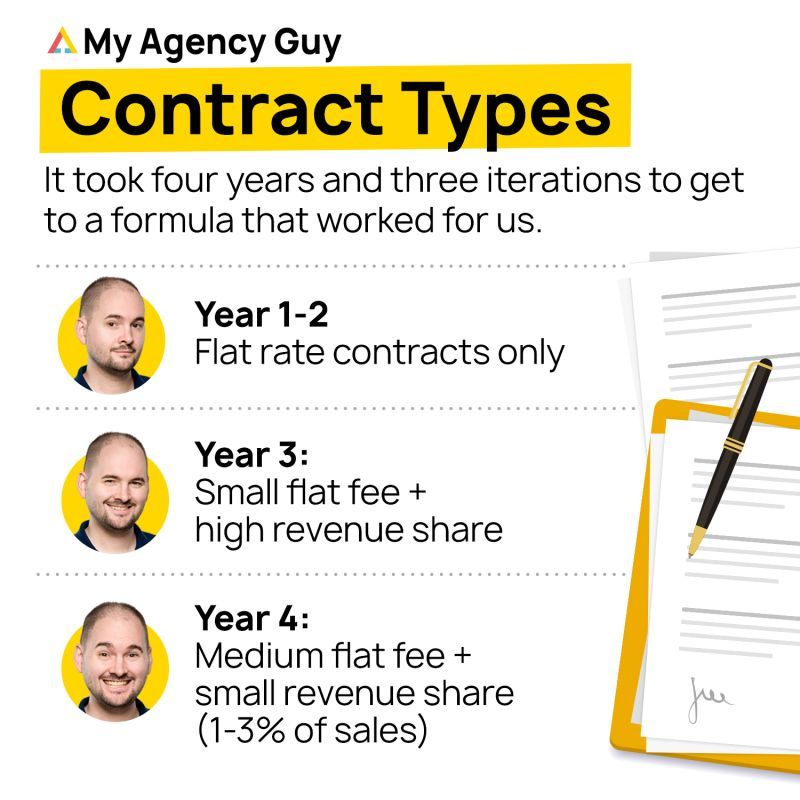
When
Negotiation and agreement typically take place after the client has accepted the agency’s proposal.
Where
Negotiation and agreement can take place in person, over the phone, or via email.
How
The negotiation process can vary depending on the client and the agency. However, some common steps include:
- Discuss the scope of work: The agency and the client should discuss the specific services that the agency will provide and the deliverables that the client expects.
- Discuss pricing: The agency and the client should discuss the pricing for the services. This may involve negotiating on the hourly rate, the total project cost, or the payment terms.
- Discuss specific requirements: The agency and the client should discuss any specific requirements that the client has, such as turnaround times, communication preferences, or reporting requirements.
- Reach an agreement: Once the agency and the client have agreed on the scope of work, pricing, and specific requirements, they can reach an agreement on the terms of the contract.
Why
Negotiation and agreement is important because it ensures that both the agency and the client have a clear understanding of the terms of the contract. This helps to avoid misunderstandings and disputes down the road.
Here are some tips for negotiating and reaching an agreement with a client:
- Be prepared: Before you start negotiating, be sure to have a clear understanding of your agency’s costs, the value that you can bring to the client, and your bottom line.
- Be flexible: Be willing to compromise on some things in order to reach an agreement.
- Be professional: Maintain a professional demeanor throughout the negotiation process.
- Get everything in writing: Once you have reached an agreement with the client, be sure to get everything in writing in a signed contract.
By following these tips, you can increase your chances of successfully negotiating and reaching an agreement with clients.
Here is an example of how to negotiate and reach an agreement with a client:
- Once the client has accepted the agency’s proposal, schedule a call to discuss the terms of the contract.
- During the call, discuss the scope of work, pricing, and any specific requirements that the client has.
- Be prepared to compromise on some things in order to reach an agreement.
- Once you have agreed on the terms of the contract, send the client a draft contract for review.
- Once the client has reviewed the contract, make any necessary changes and finalize the contract.
- Have both parties sign the contract.
6. Amazon Agency Sales Process: Onboarding
What
Onboarding is the process of transitioning the client to the Amazon agency’s workflow and systems. This includes gathering the necessary information and assets from the client, setting up access to the agency’s tools and resources, and creating a detailed plan for the upcoming work.
When
Onboarding typically takes place after the client has signed the contract with the Amazon agency.
Where
Onboarding can take place in person, over the phone, or via video call.
How
The onboarding process can vary depending on the agency and the client. However, some common steps include:
- Schedule a kickoff call: The agency and the client should schedule a kickoff call to discuss the project goals, timeline, and communication plan.
- Gather information and assets: The agency should gather the necessary information and assets from the client, such as product listings, advertising campaigns, and sales data.
- Set up access to tools and resources: The agency should set up access to the agency’s tools and resources for the client. This may include setting up access to the agency’s project management system, CRM system, and communication tools.
- Create a detailed plan: The agency and the client should create a detailed plan for the upcoming work. This may include creating a project timeline, assigning tasks to team members, and setting up regular check-ins.
Why: Onboarding is important because it helps to ensure that the project gets off to a smooth start. It also helps to build trust and rapport between the agency and the client.
Here are some tips for onboarding clients effectively:
- Be organized: Have a clear plan for the onboarding process and be prepared to answer any questions that the client may have.
- Be responsive: Be responsive to the client’s needs and requests.
- Be transparent: Keep the client informed of your progress and any challenges that you may be facing.
- Set expectations: Set clear expectations for the client in terms of communication, deliverables, and timelines.
- Get feedback: Get feedback from the client throughout the onboarding process to ensure that they are satisfied with your progress.
By following these tips, you can onboard clients effectively and set the stage for a successful project.
Here is an example of how to onboard a client:
- Schedule a kickoff call with the client to discuss the project goals, timeline, and communication plan.
- Send the client a list of the information and assets that you need from them.
- Once you have received the necessary information and assets from the client, set up access to your agency’s tools and resources.
- Schedule a follow-up call with the client to create a detailed plan for the upcoming work.
- Begin working on the project and keep the client updated on your progress.
- Get feedback from the client throughout the onboarding process to ensure that they are satisfied with your progress.
7. Amazon Agency Sales Process: Service Delivery
What
Service delivery is the process of providing the agreed-upon services to the client. This may include optimizing Amazon listings, managing ads, or other tasks.
When
Service delivery typically begins after the client has signed the contract with the Amazon agency and the onboarding process has been completed.
Where
Service delivery can take place remotely or in person, depending on the needs of the client and the agency.
How
The specific steps involved in service delivery will vary depending on the services being provided. However, some common steps include:
- Review the client’s account: The agency should review the client’s Amazon account to identify areas for improvement.
- Develop a plan: The agency should develop a plan to address the client’s specific needs and goals.
- Implement the plan: The agency should implement the plan and provide regular updates to the client.
- Monitor results: The agency should monitor the results of their efforts and make adjustments to the plan as needed.
- Communicate with the client: The agency should maintain regular communication with the client to keep them updated on their progress and to answer any questions they may have.
Why
Service delivery is important because it is the culmination of the sales process and it is where the agency has the opportunity to demonstrate its value to the client. By providing high-quality services and delivering on their promises, the agency can build trust and rapport with the client, which can lead to long-term relationships and repeat business.
Here are some tips for effective service delivery:
- Be proactive: Don’t wait for the client to come to you with problems. Be proactive in identifying and addressing their needs.
- Be responsive: When the client does have a question or concern, be responsive and timely in your response.
- Be transparent: Keep the client informed of your progress and any challenges you may be facing.
- Be overdeliver: Whenever possible, exceed the client’s expectations. This could involve going above and beyond the scope of work or delivering results sooner than expected.
- Get feedback: Get regular feedback from the client to ensure that you are meeting their needs and expectations.
By following these tips, you can provide effective service delivery to your clients and build long-term relationships.
Here is an example of how to provide service delivery to a client who has hired your agency to optimize their Amazon listings:
- Review the client’s account to identify areas for improvement.
- Develop a plan to optimize the client’s listings, including updating titles, keywords, descriptions, and images.
- Implement the plan and make adjustments as needed.
- Monitor the results of your efforts and track the client’s sales and rankings.
- Communicate regularly with the client to keep them updated on your progress and to answer any questions they may have.
8. Amazon Agency Sales Process: Regular Communication

What
Regular communication is the process of maintaining open lines of communication with the client and providing updates on progress and results. This is important for building trust and rapport with the client, and for ensuring that the project is on track and meeting their expectations.
When
Regular communication should take place throughout the sales process, from the initial consultation to the final delivery of services. The frequency of communication will vary depending on the needs of the client and the complexity of the project.
However, it is generally a good idea to communicate with the client at least once a week, even if it is just to provide a brief update on your progress.
Where
Regular communication can take place in a variety of ways, including email, phone calls, video calls, and in-person meetings. The best way to communicate with the client will depend on their preferences and on the nature of the information being communicated.
For example, if you are providing a complex update on the project, it may be best to schedule a video call so that you can share your screen and answer any questions the client may have.
How
The specific content of your regular communications with the client will vary depending on the project. However, some general tips include:
- Be clear and concise: Avoid using jargon and technical terms that the client may not understand.
- Be specific: Provide specific examples and data to support your claims.
- Be honest and transparent: If you are facing any challenges or delays, be honest with the client and let them know what you are doing to address the issue.
- Be responsive: Respond to the client’s questions and concerns promptly.
- Be positive and enthusiastic: Show the client that you are excited about the project and that you are committed to their success.
Why
Regular communication is important for a number of reasons, including:
- Builds trust and rapport: Regular communication helps to build trust and rapport with the client. When the client knows that you are keeping them informed of your progress and that you are responsive to their needs, they are more likely to trust you and to be satisfied with your services.
- Ensures that the project is on track: Regular communication helps to ensure that the project is on track and meeting the client’s expectations. By communicating regularly with the client, you can identify any potential problems early on and take steps to address them.
- Provides the client with peace of mind: Knowing that you are communicating with them regularly and that you are keeping them updated on your progress can give the client peace of mind. This is especially important for clients who are new to working with an Amazon agency or who have had negative experiences with other agencies in the past.
Overall, regular communication is essential for building and maintaining successful relationships with Amazon agency clients. By communicating regularly and effectively, you can build trust, ensure that projects are on track, and provide clients with peace of mind.
Here is an example of a regular communication schedule that you could use with your Amazon agency clients:
- Weekly email update: Send your clients a weekly email update that summarizes your progress on their project and any challenges you are facing.
- Monthly video call: Schedule a monthly video call with your clients to discuss the project in more detail and to answer any questions they may have.
- Ad hoc communication: In addition to your scheduled communications, be sure to communicate with your clients ad hoc as needed. This may involve sending them updates on important developments, such as the launch of a new advertising campaign or the release of a new Amazon feature.
9. Amazon Agency Sales Process: Performance Metrics
What
Performance metrics are quantifiable measures that can be used to track and measure the success of an Amazon Agency Sales Process. Some common performance metrics include:
- Sales growth: The percentage increase in sales from one period to the next.
- Return on investment (ROI): The amount of money earned in relation to the amount of money invested.
- Ad performance: The performance of advertising campaigns, measured in terms of clicks, impressions, and conversions.

When
Performance metrics should be tracked and reported on regularly, such as weekly, monthly, or quarterly. This will help the agency to identify trends, track progress over time, and make necessary adjustments to their strategies.
Where
Performance metrics can be tracked and reported on using a variety of tools and resources, such as Amazon’s Seller Central platform, third-party analytics tools, and custom reporting tools.
How
The specific steps involved in tracking and reporting on performance metrics will vary depending on the tools and resources being used. However, some general steps include:
- Identify the key performance metrics to track: The agency should identify the key performance metrics that are most relevant to their clients’ goals.
- Collect data: The agency should collect data on the key performance metrics using the appropriate tools and resources.
- Analyze the data: The agency should analyze the data to identify trends and track progress over time.
- Report on the results: The agency should report on the results to their clients regularly.
Why
Tracking and reporting on performance metrics is important for several reasons, including:
- Demonstrates value to clients: By tracking and reporting on performance metrics, the agency can demonstrate the value of their services to their clients. This can help to build trust and rapport, and it can lead to repeat business.
- Identifies areas for improvement: By tracking performance metrics, the agency can identify areas where they can improve their services. This can help them to better meet the needs of their clients and to achieve their desired results.
- Keeps the agency on track: Tracking performance metrics can help the agency to stay on track and to achieve its own goals. By setting targets for the key performance metrics, the agency can work towards those targets and measure its progress over time.
Overall, tracking and reporting on performance metrics is an essential part of the Amazon agency sales process. By tracking and reporting on the right metrics, the agency can demonstrate value to clients, identify areas for improvement, and keep the agency on track.
Here is an example of how an Amazon agency might track and report on performance metrics for a client:
- The client’s goal is to increase sales by 10% in the next quarter. The agency will track the client’s sales growth every week and report the results to the client at the end of each week. If the client is not on track to achieve their goal, the agency will work with the client to develop a plan to improve their performance.
- The agency will also track the client’s ROI on their advertising campaigns. This will help the agency to identify which campaigns are performing well and which campaigns need to be improved. The agency will report the ROI results to the client monthly.
- Finally, the agency will track the performance of the client’s ad campaigns in terms of clicks, impressions, and conversions. This will help the agency to identify which keywords are performing well and which keywords need to be changed. The agency will report the ad performance results to the client weekly.
10. Amazon Agency Sales Process: Client Education
What
Client education is the process of providing clients with the knowledge and skills they need to better understand and manage their Amazon business. This can be done through a variety of methods, including:
- Courses and workshops: The agency can offer courses and workshops on topics such as Amazon listing optimization, advertising, and account management.
- Blog posts and articles: The agency can write blog posts and articles on Amazon-related topics and publish them on their website or social media channels.
- Ebooks and whitepapers: The agency can create ebooks and whitepapers on Amazon-related topics and offer them to clients for free.
- One-on-one coaching: The agency can offer one-on-one coaching to clients to help them with specific areas of their Amazon business.
When
Client education can be offered at any stage of the sales process, from the initial consultation to the post-sale support phase. However, it is especially important to offer client education to new clients or to clients who are not familiar with Amazon or who are struggling with their Amazon business.
Where
Client education can be delivered in a variety of ways, including:
- Online: The agency can offer online courses and workshops, or they can publish blog posts, articles, ebooks, and whitepapers on their website.
- In-person: The agency can offer in-person courses and workshops, or they can provide one-on-one coaching to clients.
How
The specific method of delivering client education will depend on the agency’s resources and the needs of the client. However, some general tips for delivering effective client education include:
- Tailor the content to the client’s needs: The agency should tailor the content of their client education programs to the specific needs of their clients. For example, an agency that works with new Amazon sellers may want to offer courses on the basics of Amazon selling, such as how to create a product listing and how to manage inventory.
- Make the content engaging: The agency should make their client education content engaging and informative. This can be done by using a variety of media, such as videos, infographics, and interactive exercises.
- Provide opportunities for feedback: The agency should provide opportunities for clients to provide feedback on their client education programs. This will help the agency to improve their programs over time.
Why
Client education is important for a number of reasons, including:
- Empowers clients: Client education empowers clients to better understand and manage their Amazon business. This can lead to increased sales and profits for the client.
- Builds trust and rapport: Client education helps the agency to build trust and rapport with their clients. When clients feel like the agency is invested in their success, they are more likely to trust the agency and to continue working with them.
- Differentiates the agency from the competition: Client education is a way for the agency to differentiate themselves from the competition. By offering high-quality client education programs, the agency can show potential clients that they are experts in Amazon and that they are committed to their clients’ success.
11. Amazon Agency Sales Process: Client Retention
What
Client retention is the process of keeping existing clients happy and engaged with the agency’s services. This is important because it is often more cost-effective to retain existing clients than it is to acquire new clients.
When
Client retention should be a focus throughout the sales process, from the initial consultation to the post-sale support phase. However, it is especially important to focus on client retention after the client has signed a contract and the agency has begun providing services.
Where
Client retention can be achieved through a variety of methods, including:
- Providing exceptional results: The agency should strive to provide exceptional results for their clients. This means meeting or exceeding their clients’ goals and expectations.
- Offering excellent customer service: The agency should offer excellent customer service to their clients. This means being responsive to their needs, being helpful and supportive, and being proactive in addressing any issues.
- Building relationships: The agency should build relationships with their clients. This means getting to know them on a personal level and understanding their business needs.
How
Here are some specific tips for achieving client retention:
- Set clear expectations: Make sure that your clients understand what to expect from your services. This includes setting clear goals, timelines, and budgets.
- Overcommunicate: Keep your clients updated on your progress and any challenges you may be facing. Be transparent and honest with them.
- Be responsive: Respond to your clients’ questions and concerns promptly and professionally.
- Go the extra mile: Look for ways to go the extra mile for your clients. This could involve providing them with additional services or resources, or simply being there for them when they need help.
- Get feedback: Ask your clients for feedback on your services. This will help you to identify areas where you can improve.
Why
Client retention is important for a number of reasons, including:
- Increases revenue: Retaining existing clients can help to increase the agency’s revenue. This is because it is often more cost-effective to retain existing clients than it is to acquire new clients.
- Improves profitability: Retaining existing clients can help to improve the agency’s profitability. This is because existing clients are more likely to spend more money with the agency over time.
- Reduces churn: Retaining existing clients can help to reduce the agency’s churn rate. Churn is the percentage of clients that stop working with the agency in a given time. By reducing churn, the agency can increase its overall client base.
- Improves reputation: A high client retention rate can help to improve the agency’s reputation. This is because potential clients are more likely to trust and work with an agency that has a good reputation for keeping its clients happy.
Here’s a post you can read to discover how to retain clients.
12. Amazon Agency Sales Process: Feedback and Improvement
What
Feedback and improvement is the process of gathering feedback from clients to identify areas for improvement and implementing changes to enhance service quality.
When
Feedback and improvement should be an ongoing process throughout the sales process and beyond. The agency should collect feedback from clients at every stage of the process, from the initial consultation to the post-sale support phase. This will help the agency to identify areas where they can improve their services and better meet the needs of their clients.
Where
Feedback can be collected from clients in a variety of ways, including:
- Surveys: The agency can send surveys to clients to collect feedback on their services.
- Interviews: The agency can interview clients to collect more in-depth feedback.
- Client satisfaction scores: The agency can track client satisfaction scores to get a general sense of how happy their clients are with their services.
- Social media: The agency can monitor social media to see what clients are saying about their services.
How
Once the agency has collected feedback from clients, they need to analyze the feedback and identify areas for improvement. The agency should then develop and implement a plan to address the areas for improvement.
Here are some specific tips for gathering and implementing feedback:
- Make it easy for clients to provide feedback: Provide clients with multiple ways to provide feedback, such as through surveys, interviews, and social media.
- Be responsive to feedback: When clients provide feedback, be sure to respond to them promptly and professionally. Thank them for their feedback and let them know that you are taking it seriously.
- Analyze the feedback: Once you have collected feedback, analyze it to identify areas for improvement. Look for common themes and patterns in the feedback.
- Develop a plan to address the feedback: Develop a plan to address the areas for improvement that you identified in the feedback. This plan should include specific goals, timelines, and resources.
- Implement the plan: Implement the plan to address the areas for improvement. Be sure to monitor the results of your efforts and make adjustments as needed.
Why
Feedback and improvement are important for many reasons, including:
- Improves service quality: By gathering and implementing feedback, the agency can improve the quality of its services. This can lead to increased sales and profits for the agency, as well as happier and more satisfied clients.
- Builds trust and rapport: By being responsive to feedback and showing that they are committed to improving their services, the agency can build trust and rapport with their clients. This can lead to longer-term relationships and repeat business.
- Differentiates the agency from the competition: By focusing on feedback and improvement, the agency can differentiate itself from the competition. This is because clients are more likely to work with an agency that is committed to providing high-quality services and to improving their services over time.
13. Amazon Agency Sales Process: Upselling and Cross-Selling
What
Upselling and cross-selling are sales techniques that can be used to increase revenue from existing clients. Upselling involves offering a client a more expensive or upgraded version of the product or service that they are already interested in. Cross-selling involves offering a client a related or complementary product or service to the one that they are already interested in.
When
Upselling and cross-selling can be done at any stage of the sales process, from the initial consultation to the post-sale support phase. However, it is important to be mindful of the client’s needs and budget. The agency should not try to upsell or cross-sell a client if they are not interested or if it is not in their best interests.
Where
Upselling and cross-selling can be done in a variety of ways, including:
- In-person: The agency can upsell and cross-sell clients in person during meetings or consultations.
- Over the phone: The agency can upsell and cross-sell clients over the phone during sales calls or support calls.
- Email: The agency can upsell and cross-sell clients via email by sending them targeted offers or recommendations.
- Website: The agency can upsell and cross-sell clients on their website by displaying related products and services on product pages or by offering product bundles.
How
Here are some specific tips for upselling and cross-selling clients:
- Identify opportunities: The agency should identify opportunities to upsell and cross-sell clients by understanding their needs and budget. The agency can also use data analytics to identify opportunities. For example, the agency could analyze a client’s sales data to identify products that they are selling well and products that they are not selling well. The agency could then offer the client complementary products to the ones that they are selling well, or they could offer the client more comprehensive packages.
- Make it easy for clients to say yes: The agency should make it easy for clients to say yes to upsells and cross-sells. This could involve offering discounts, bundles, or other incentives. The agency should also present the upsell or cross-sell in a way that benefits the client. For example, the agency could highlight the features and benefits of the upgraded product or service, or they could explain how the related product or service could help the client to achieve their business goals.
- Follow up: The agency should follow up with clients after they have made an upsell or cross-sell. This is an opportunity to ensure that the client is happy with their purchase and to answer any questions they may have.
Why
Upselling and cross-selling are important for a number of reasons, including:
- Increase revenue: Upselling and cross-selling can help to increase the agency’s revenue. This is because it is often easier and more cost-effective to sell to existing clients than it is to acquire new clients.
- Improve profitability: Upselling and cross-selling can help to improve the agency’s profitability. This is because the agency can typically make a higher profit on upsells and cross-sells than they can on new sales.
- Increase customer lifetime value: Upselling and cross-selling can help to increase the customer lifetime value (CLV) of the agency’s clients. CLV is the total revenue that the agency expects to generate from a client over the lifetime of their relationship. By upselling and cross-selling, the agency can increase the amount of money that their clients spend with them over time.
14. Amazon Agency Sales Process: Renewal and Expansion
What
Renewal and expansion is the process of renewing contracts with satisfied clients and exploring opportunities to expand the agency’s services to those clients.
When
Renewal and expansion should be a priority in the sales process, especially for clients who are happy with the agency’s services and who are growing their Amazon businesses. The agency should start planning for renewal and expansion early on in the relationship with the client. This will help the agency to better understand the client’s needs and to develop a plan to meet those needs.
Where
Renewal and expansion can be discussed with clients in person, over the phone, or via email. However, it is important to have a personal conversation with the client to discuss their needs and to build trust.
How
Here are some specific tips for renewal and expansion:
- Understand the client’s needs: The agency should meet with the client to discuss their needs and their goals for the future. This will help the agency to develop a plan to meet the client’s needs and to help them achieve their goals.
- Develop a proposal: The agency should develop a proposal that outlines the services that they are offering to the client and the benefits of those services. The proposal should also include a pricing structure and a timeline for delivery.
- Negotiate the contract: The agency should negotiate the contract with the client to ensure that both parties are satisfied with the terms. The contract should be clear and concise, and it should outline all of the terms of the agreement.
- Onboard the client: Once the contract is signed, the agency should onboard the client to their new services. This may involve providing the client with access to the agency’s tools and resources, and it may also involve training the client on how to use the new services.
- Manage the relationship: The agency should manage the relationship with the client on an ongoing basis. This involves communicating regularly with the client, providing them with updates on their progress, and addressing any concerns they may have.
Why
Renewal and expansion are important for a number of reasons, including:
- Increased revenue: Renewal and expansion can help to increase the agency’s revenue. This is because it is often easier and more cost-effective to retain and expand existing clients than it is to acquire new clients.
- Improved profitability: Renewal and expansion can help to improve the agency’s profitability. This is because the agency can typically make a higher profit on renewal and expansion clients than they can on new clients.
- Reduced churn: Renewal and expansion can help to reduce the agency’s churn rate. Churn is the percentage of clients that stop working with the agency in a given period of time. By reducing churn, the agency can increase its overall client base.
- Improved reputation: A high renewal and expansion rate can help to improve the agency’s reputation. This is because potential clients are more likely to trust and work with an agency that has a good reputation for retaining and expanding its clients.
Here are some videos you can watch to know more about managing and growing an Amazon agency:
15. Amazon Agency Sales Process: Referral Program
What
A referral program is a marketing strategy that encourages satisfied clients to refer your agency to others. This is a great way to generate new leads and sales, as people are more likely to trust and do business with companies that have been referred to them by friends, family, or colleagues.
When
The best time to ask clients for referrals is when they are happy with the services you have provided. This could be at the end of a project, after you have helped them achieve a significant milestone, or simply after you have gone above and beyond to meet their needs.
Where
You can ask clients for referrals in person, over the phone, or via email. However, it is often most effective to ask for referrals in person or over the phone, as this gives you an opportunity to build rapport with the client and to explain the benefits of the referral program.
How
Here are some specific tips for asking clients for referrals:
- Be genuine: Make sure that you are genuinely grateful for the client’s business and that you are confident in your ability to help their referrals.
- Be specific: Tell the client exactly what you are asking them to do. For example, you could say, “Would you be willing to refer my agency to your colleagues who are looking for help with Amazon marketing?”
- Make it easy: Provide the client with the resources they need to make referrals, such as your website address or a referral form.
- Offer incentives: Consider offering clients incentives for referrals, such as discounts on future services or gift cards.
Why
There are many benefits to having a referral program, including:
- Increased leads and sales: A referral program can help you to generate new leads and sales, as people are more likely to do business with companies that have been referred to them by friends, family, or colleagues.
- Reduced marketing costs: A referral program can help to reduce your marketing costs, as you do not need to spend as much money on paid advertising or other marketing channels.
- Improved reputation: A referral program can help to improve your reputation, as it shows that your clients are happy with your services and that they are willing to recommend you to others.
16. Amazon Agency Sales Process: Long-term Relationship Building
What
Long-term relationship building is the process of developing and maintaining strong relationships with clients over time. This is important because it can lead to repeat business, increased revenue, and a better reputation for the agency.
When
Long-term relationship building should start as soon as the agency begins working with a client. The agency should demonstrate their commitment to the client’s success by providing high-quality services, communicating regularly, and being responsive to the client’s needs.
Where
Long-term relationship building can take place in a variety of ways, including:
- In-person meetings: The agency can meet with clients in person to discuss their needs, provide updates on their progress, and build rapport.
- Phone calls: The agency can call clients to discuss their needs, provide updates on their progress, and answer any questions they may have.
- Emails: The agency can email clients to provide updates on their progress, share relevant information, and offer support.
- Social media: The agency can connect with clients on social media to share news, engage in conversation, and offer support.
How
Here are some specific tips for building long-term relationships with clients:
- Be responsive: Respond to client inquiries promptly and professionally.
- Be transparent: Keep clients informed of your progress and any challenges you may be facing.
- Be proactive: Anticipate client needs and offer solutions before they ask.
- Go the extra mile: Do more for clients than they expect.
- Build trust: Be honest and ethical in your dealings with clients.
Why
Long-term relationship building is important for a number of reasons, including:
- Increased revenue: Long-term clients are more likely to spend more money with the agency over time.
- Improved profitability: Long-term clients are typically more profitable than new clients, as they require less investment in marketing and sales.
- Reduced churn: Long-term clients are less likely to switch to another agency.
- Improved reputation: A strong reputation for building long-term relationships with clients can attract new clients and help the agency to stand out from the competition.
Overall, long-term relationship building is an essential part of the Amazon agency sales process. By building long-term relationships with clients, the agency can increase revenue, improve profitability, reduce churn, and improve its reputation.
Here are some examples of how an Amazon agency can foster long-term relationship building with its clients:
- Regularly communicate with clients about their progress and results. This can be done through weekly email updates, monthly video calls, or other means.
- Be proactive in identifying and addressing client needs. Don’t wait for clients to come to you with problems. Regularly review their accounts and look for areas where you can improve.
- Offer clients educational resources and support. This can include blog posts, webinars, e-books, or one-on-one coaching.
- Go above and beyond to help clients achieve their goals. This could involve working extra hours, offering a discount on services, or providing free consultations.
- Build personal relationships with clients. Get to know them on a personal level and show that you care about their success.
Here is a video can watch to learn more:
Conclusion
By following the steps in an Amazon Agency Sales Process, you can attract new clients, keep existing clients happy, and help your agency succeed in the competitive Amazon marketplace.
Starting and scaling an Amazon agency is not a simple feat, but we can provide you with expert guidance to help pave your way to success.

